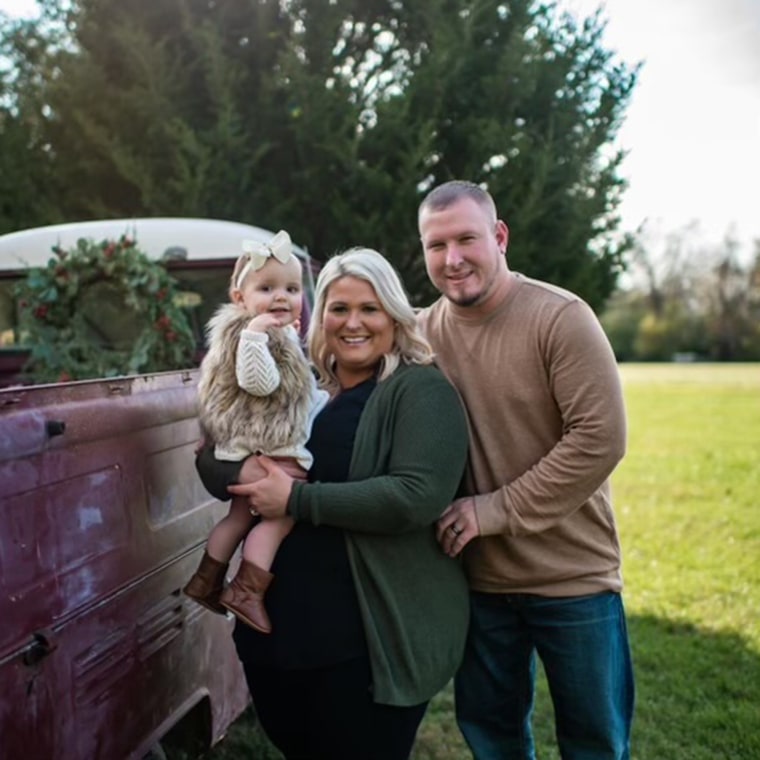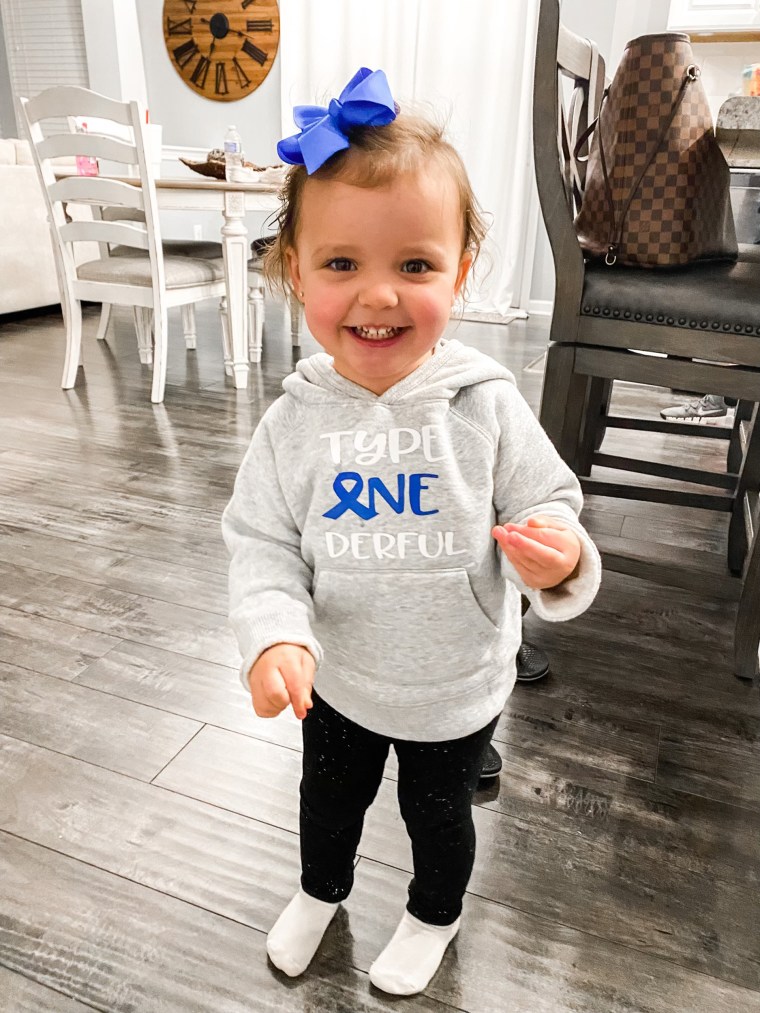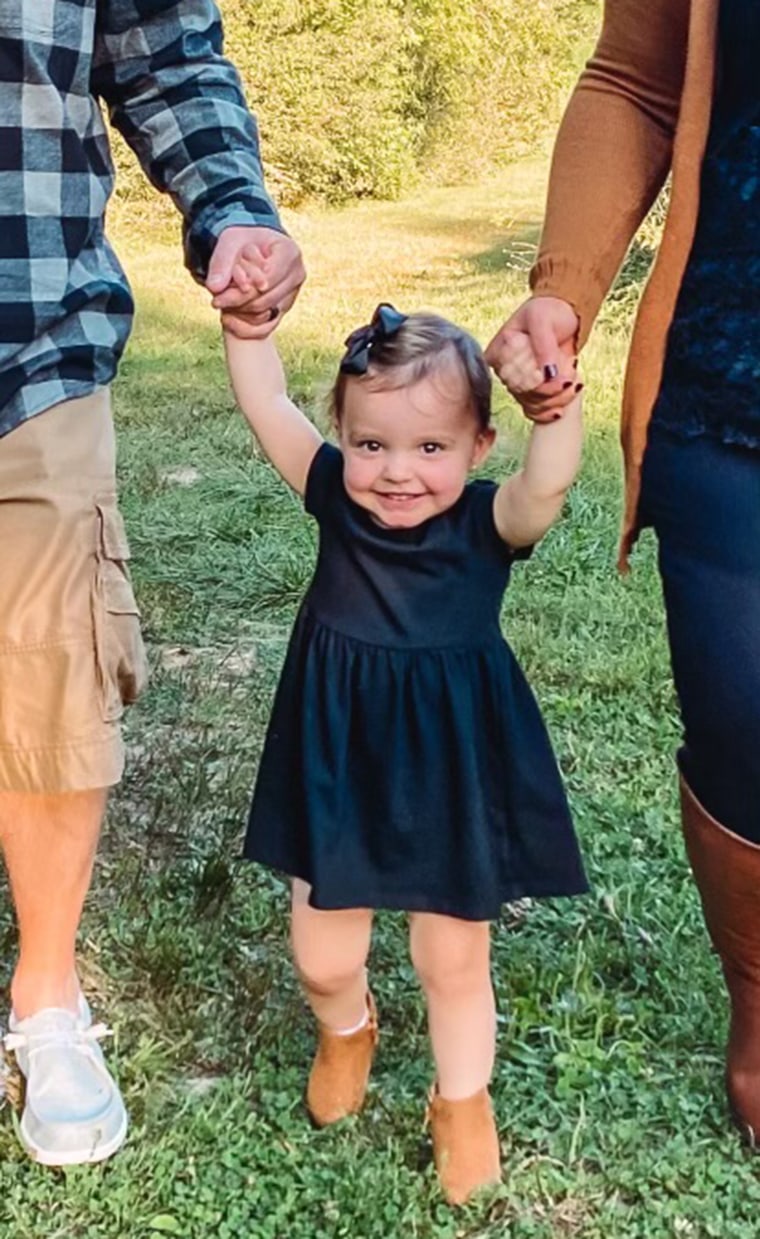This past spring, Layla Henschen, 2, kept "chugging" water, her mom Ashley Henschen recalls. At first, she wondered if it was the heat that made her daughter so thirsty.
“She would drink almost two cups worth of water each time,” Henschen, 33, from Indianapolis, tells TODAY.com. “Her diapers were just constantly wet. We would change her diaper. Then within 30 minutes, it would be drenched, so it would need to be changed. She was 22 months at the time, so that’s unusual to be soaking that quick.”
Henschen was pretty sure something was off with her daughter's thirst and urination, and changing her diapers had gotten exhausting, so she decided to call the doctor. That led Layla to receive a Type 1 diabetes diagnosis before becoming much sicker.

“I just trusted my gut,” Henschen says. “Her blood sugar was around 500, whereas a normal blood sugar for someone her age should be between 80 and 100.” Drinking, soaking through diapers, eating more
Starting in May 2022, Henschen noticed that Layla constantly drank water. Temperatures were warming up, so Henschen thought Layla was adjusting to the heat. Although, Henschen worried about Layla soaking through all her diapers.
“I was thinking, ‘Do we need to size up in diapers? Do we need overnight diapers?’” Henschen says.
But then she noticed her daughter was acting irritated and frequently in the pantry grabbing snacks. Still, it felt hard to understand if these behavior changes were a new development phase or a problem.
“We kind of brushed it off. ‘She's growing,’” Henschen recalls. “It seemed like every sign and symptom could easily be brushed off as something else.”
Layla's parents initially attributed her attitude shift to "the terrible twos."
“She was pretty irritable. It was hard to go to a restaurant at that time," Henschen says. "We had gone on a trip, and she was just really terrible the whole time. They warn you about going out with your 2-year-old to a restaurant and stuff. So, she had all the signs, but because we didn’t know what to look for, (we missed it).”
After two weeks of Layla consistently soaking through her diapers such that every morning Henschen needed to change all her bedding, Henschen had had enough and called the pediatrician.
“One of the nurse’s questions was, ‘Is she waking up drenched every morning?’ and I said, ‘Yes,” Henschen shares.

The nurse told Henschen to bring Layla in immediately. After a urine test, doctors noticed Layla’s elevated blood glucose levels and diagnosed her with diabetes.
“It was never a thought in my mind,” Henschen says. “I was so confused. They said (her blood sugar) is this high, you need to rush to Riley (Hospital for Children) right now, and they talked about her being (in) the pediatric intensive care unit, and it was just such an overwhelming experience. ... It was just so shocking.”
When Layla arrived at the hospital, doctors ran some more tests and discovered she was experiencing diabetic ketoacidosis, which occurs when a person doesn’t have enough insulin to convert sugar into energy. Instead, the liver uses fat as fuel, causing a build-up of ketones, which at high levels can be dangerous, according to the Centers for Disease Control and Prevention.
Henschen took her daughter to the doctor at the right time.
“They were like, ‘How did you catch this? When we see patients come in with this high blood sugar, usually it’s to the point where they’re going into a diabetic coma,’” the mom says. “They said it was diabetes. ... I knew Type 1 was worse, and when they said Type 1, it was just the most shocking thing.”
Type 1 diabetes
“Type 1 diabetes is diabetes due to insulin deficiency, and the most common cause of Type 1 diabetes is autoimmune,” Dr. Tamara Hannon, director of the Pediatric Diabetes Program at Riley Hospital for Children, who did not treat Layla, tells TODAY.com. “Over time, the autoimmune reaction destroys these pancreatic beta cells such that the body cannot make enough insulin to support its needs.”

Signs of Type 1 diabetes include:
- Increased frequency in urination
- Increased thirst
- Eating more than usual
- Feeling hungry more often
“Parents notice their child may be using the bathroom more than usual, urinating more than usual, and drinking more than usual,” Hannon says. “It means a lot of eating. Not having insulin is like starving.”
Insulin, a hormone, helps the body take the energy from sugar in the cells. But without it, the sugar and fat aren’t properly stored and converted into energy. That means even when people eat more, they aren’t gaining weight.
“Unexpected weight loss is another symptom,” Hannon says. “If the diabetes becomes more severe before these symptoms are detected, a person can be very very ill. They could have belly pain. They could feel sick.”
When parents notice these symptoms, they should call their pediatrician for an appointment, she says. "A simple blood test can diagnose diabetes,” she adds.

People with Type 1 diabetes need to take insulin throughout their lives. They cannot rely on the medications that can help people with Type 2 diabetes manage their blood glucose levels.
“If you are not making insulin, you need to replace insulin,” she says. “In Type 1 diabetes, insulin is absolutely necessary.”
Layla’s life with Type 1 diabetes
Layla stayed in the hospital for two days after her diagnosis. While she was there, Henschen and her husband learned how to care for a child with Type 1 diabetes.
“It was really hard to accept it, and you want to grieve, but you need to accept it first, and there are so many emotions,” she says. “I had to put my emotions aside and learn how to take care of my baby. That’s the only choice I had.”
Almost immediately, the family noticed a change in Layla’s mood.
“She’s happier now. We know that she just wasn’t feeling good, and her attitude changed when we were in the hospital,” Henschen says. “She was running around the room.”

There’s been a bit of a learning curve. Layla was used to grabbing a snack when she was hungry, but now Henschen needs to read the labels to see how many carbs are in it and if Layla might need an insulin shot to enjoy the food. They’re trying to associate the insulin with something fun.
“We give her a high five after her injections,” Henschen says. “It’s so crazy seeing a 2-year-old that’s so strong and brave.”
Layla wears a blood glucose monitor on her arm, which delivers real-time readings of her blood sugar to her parents' phones.
“We don’t have to check her sugar with a finger poke before meals, which is nice. But it’s hard because she also doesn’t understand,” Henschen says. “Distracting her or let’s do the high five, that really helps.”
After her daughter's diagnosis, Henschen worried Layla could only eat sugar-free sweets, but she's learned that’s a “kind of stereotype.”
“It just may require more insulin,” she says. “We don’t try to restrict her from anything, and even when she grows up, I don’t want her to feel like she is left out or she can’t have what her friends are having.”
While having a child with Type 1 diabetes requires a bit more planning, life hasn’t changed too dramatically. Henschen hopes that when others hear about their story, they’ll seek help if notice something wrong with their child.
“Trust your motherly if you think something’s wrong,” she says. “The worst the doctor can say is, ‘No, she’s fine.’”